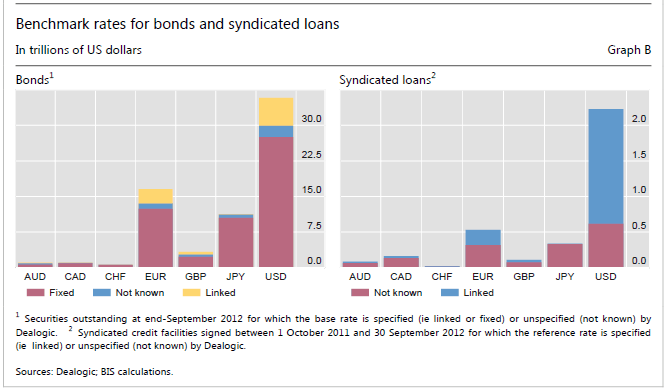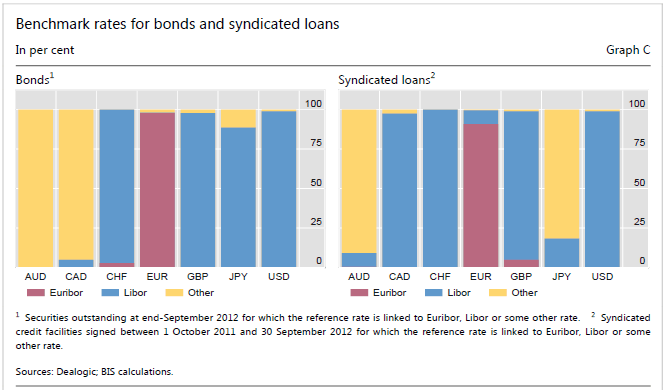The importance of reference rates
(Extract from pages 21-22 of BIS Quarterly Review, December 2012)
Libor, Euribor and similar rates have become the key reference or benchmark rates used in contracts such as interest rate derivatives, floating rate loans and mortgages, with hundreds of trillions of dollars outstanding. Libor was introduced in 1986 as an alternative to Treasury bill (T-bill) and bilaterally negotiated interest rates in floating rate loans and interest rate swaps. This private sector initiative filled an important gap: T-bill rates had become poor proxies for marginal funding costs for the larger globally active banks owing to the flight to quality following the Latin American debt crisis.1 Furthermore, bilaterally negotiated benchmarks were cumbersome to use. Thanks to the great convenience of having a single benchmark for trading interest rate risk, the use of Libor and similar benchmarks grew rapidly. However, since 2008 the reliability and integrity of Libor and other reference rates have been called into question by evidence that some contributors misstated their borrowing costs.2
This box provides evidence on how widely reference rates such as Libor and Euribor are used. We estimate that 14% of all outstanding bonds pay interest that is linked to an identifiable reference rate, and 79% pay a fixed rate; the rate on the remaining 7% cannot be identified with the available data (Graph B). The proportion of variable rate bonds linked to an identifiable reference rate varies across currencies, ranging from 1% for the Japanese yen to 19% for sterling. In the syndicated loan market, the proportion of debt whose interest payments are linked to identifiable reference rates is much higher. At least 54% of the loans originated between October 2011 and September 2012 are linked to Libor, Euribor or a similar reference rate. For the remaining loans, we do not have any information on whether they are linked to a particular reference rate.
Although several benchmark rates are available for most currencies, the vast majority of bonds and syndicated loan contracts are linked to a single benchmark. For instance, 98% of all euro-denominated floating rate bonds and 91% of the syndicated loans with identified benchmarks in that currency are linked to Euribor (Graph C). Euro Libor exists, but seems to be little used in debt markets. By contrast, the US dollar market is dominated by Libor, with 99% of floating rate bonds and syndicated loans with identifiable benchmarks linked to this particular rate. It is interesting to go beyond the top currencies and look at smaller markets. Some, such as the Swiss franc market, are dominated by Libor, which even serves as policy rate for the Swiss National Bank. By contrast, both the Australian and Canadian dollar markets are dominated by local benchmark rates.
1 See R McCauley, "Benchmark tipping in the money and bond markets", BIS Quarterly Review, March 2001, pp 39-45.
2 See United Kingdom Financial Services Authority, Final Notice to Barclays Bank Plc, 27 June 2012, for a particularly well documented case. Similar allegations have been made in other jurisdictions and have led to prosecution. See The Wheatley Review of Libor: final report, September 2012, for the UK authorities' response.



